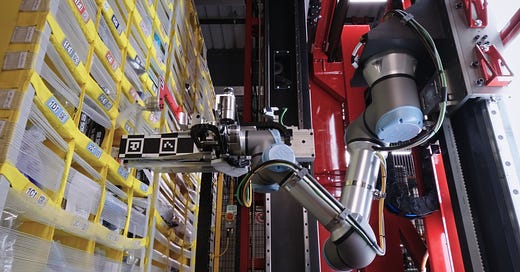Meet Vulcan, the latest Amazon robotics deployment that news outlets are covering with cloying adoration
Is "the sense of touch" the ability not to crush a bag of Skittles?
It just so happened that my article demonstrating that Amazon is most certainly automating away a significant number of jobs came out a day after the introduction of Vulcan, Amazon’s newest robotics deployment that is promising to automate much of the baseline stowing/picking role at Amazon Fulfillment Centers.
Everyone knows that the mainstream media is in a bad way, but nothing so illustrates its decrepit state of being as the way in which Amazon press releases are handled: if not repeated verbatim in news coverage, amplified in their inanity by reporters who seem like they’re interviewing for a job in Amazon’s Communications department.
This CNBC report is a real doozy in this regard:
First, it’s no doubt that Vulcan is pretty cool: robotic arm grippers have been around for a long time, and are more or less coincident with the rollout of industrial robots in the 50s and 60s. But the agility of Vulcan is what makes it special: the ability to hold a wide variety of items (basically anything 8 pounds or under at a small sortable Fulfillment Center, which Amazon says is about 75% of the items processed there) without crushing them (i.e., grip too tight) or dropping them (i.e., grip too loose), and then to find a space for them in the stacks. All things that human beings can do with minimal thought, but a difficult thing for robots.
What Amazon’s not highlighting in these stories is that there’s another reason that they like Vulcan, and that’s that it can work with its existing mesh-band inventory stacks. Up until now, the deployment of the Sequoia system at its SHV1 Fulfillment Center in Shreveport, LA has been the highlight of its automation efforts, one that has been bragged about again and again in news stories and investor calls. Sequoia similarly automates much (60%) of the picking/stowing role, but it requires the installation of new blue bins (they kind of look like milk crates) to operate. Here are those bins:
And here’s Vulcan working with the more common inventory stacks:
Those yellow towers moved around by Kivas are already in most Fulfillment Centers; the blue bins are not. So Vulcan requires both less investment and less operational disruption to deploy than Sequoia - that’s really the key leap here for Amazon.
Instead of accurately portraying the importance of Vulcan to Amazon, however, most stories have run with the company’s own line that it has learned how to give robots “a sense of touch.”
AI discourse is frustrating for any number of reasons, but the most prominent one to my humanist self is that it’s a medium wherein human capacities and needs are so flattened that they become unrecognizable. Think about what is involved in touch. Think about the wide range of memories and associations and experiences that human touch have made possible. Now imagine an alien coming down to earth and describing “the sense of touch” in terms of the ability to not crush a bag of Skittles.
That is what Amazon’s Director of Applied Science Aaron Parness is touring around doing at the moment, and every news outlet is ready to repeat it without the slightest skepticism. This is a problem not simply because it is wrong, but also because it makes Amazon’s robotics people seem like they are modern wizards, when in fact they are simply capable engineers oriented towards Amazon’s bottom line. It’s an important distinction because Amazon takes a great deal of interest in its “genius” image: they want their investors to think they’re geniuses. They want their workers to be constantly fearful that they will soon be replaced by the inventions of "geniuses.” The image of “genius” is a very material concern for Amazon, and anyone who participates in bolstering it is essentially working for Amazon.
The second big offense here concerns what this means for the human workforce, and again CNBC simply repeats Amazon’s line a) that it’s not aiming for a “dark warehouse,” i.e., a warehouse operating with no humans, and b) that automation deployments have created many new categories of jobs that are more interesting than picking/stowing. The latter is true, though they’re simply not creating as many jobs as they’re shedding. That said, if I were working at Amazon right now, I’d try to take advantage of the internal RME upskilling program.
The former is a convenient strawman argument: at one point the analyst who’s interviewed says that “removing the last human” wouldn’t be feasible if the robots broke, but no one’s talking about removing the last human. The relevant question concerns whether or not Amazon is removing many humans from their warehouses, and the answer to that is unquestionably “Yes.” But not once does a realistic assessment of Amazon’s technological drive toward employment reduction come up in the story.
So shame on you CNBC, but really shame on everyone covering this story.
P.S. You can find a brief primer on Amazon robots here, but I’ll obviously have to update it now with this news.




